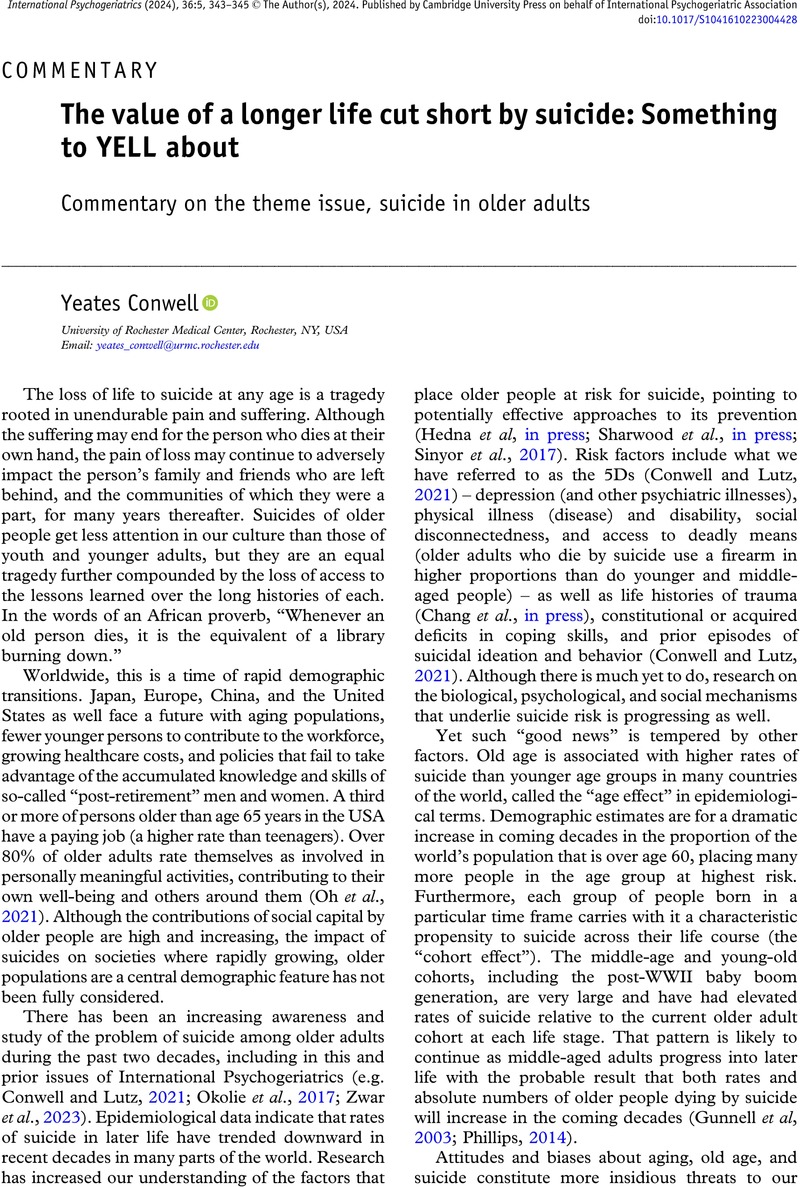No CrossRef data available.
Article contents
The value of a longer life cut short by suicide: Something to YELL about
Commentary on the theme issue, suicide in older adults
Published online by Cambridge University Press: 29 May 2024
Abstract
An abstract is not available for this content so a preview has been provided. Please use the Get access link above for information on how to access this content.

- Type
- Commentary
- Information
- International Psychogeriatrics , Volume 36 , Special Issue 5: Issue Theme: Suicide in Older Adults , May 2024 , pp. 343 - 345
- Copyright
- © The Author(s), 2024. Published by Cambridge University Press on behalf of International Psychogeriatric Association
References
Chang, Y., Buerke, M., Galfalvy, H. and Szanto, K. (in press). Childhood Trauma is Associated With Early-onset but Not Late-onset Suicidal Behavior in Late-life Depression. International Psychogeriatrics.CrossRefGoogle Scholar
Conner, K. R., Conwell, Y., Duberstein, P. R. and Eberly, S. (2004). Aggression in suicide among adults ages 50 and over. American Journal of Geriatric Psychiatry, 12, 37–42.CrossRefGoogle Scholar
Conwell, Y. et al. (2000). Completed suicide among older patients in primary care practices: a controlled study. Journal of the American Geriatrics Society, 48, 23–29.CrossRefGoogle ScholarPubMed
Conwell, Y. and Lutz, J. (2021). Lifespan development and suicide in later life. International Psychogeriatrics, 33, 117–119. https://doi.org/10.1017/S1041610220003695.CrossRefGoogle ScholarPubMed
Dempsey, M. (1947). Decline in tuberculosis: the death rate fails to tell the entire story. American Review of Tuberculosis, 56, 157–164.Google ScholarPubMed
French, D. (2023). The hidden moral injury of “OK Boomer”. New York Times, https://www.nytimes.com/2023/10/08/opinion/aging-feinstein-biden-trump.html. Accessed November 10, 2023.Google Scholar
Gardner, J. W. and Sanborn, J. S. (1990). Years of potential life lost (YPLL) – what does it measure? Epidemiology, 1, 322–329.CrossRefGoogle ScholarPubMed
Gunnell, D., Middleton, N., Whitley, E., Dorling, D. and Frankel, S. (2003). Influence of cohort effects on patterns of suicide in England and Wales, 1950-1999. British Journal of Psychiatry, 182, 164–170. https://doi.org/10.1192/bjp.182.2.164.CrossRefGoogle ScholarPubMed
Hahn, R. A. (1995). Years of accumulated ability lost (YAAL): a new measure for public health. Technology, 332, 101–103.Google Scholar
Hahn, R. A. (2023). Measuring the oss of age-associated knowledge and skills in the U.S. population, 2020. Aging and Health Research, 3, 100129. https://doi.org/10.1016/j.ahr.2023.100129.CrossRefGoogle Scholar
Hedna, K., Sigström, R., Johnell, K. and Waern, M. (in press). Determinants of Suicidal Behavior in Dementia: A Swedish National Register-based Study. International Psychogeriatrics.Google Scholar
Oh, A. et al. (2021). Engagement in meaningful activities among older adults with disability, dementia, and depression. JAMA Internal Medicine, 181, 560–562. https://doi.org/10.1001/jamainternmed.2020.7492.CrossRefGoogle ScholarPubMed
Okolie, C., Dennis, M., Simon Thomas, E. and John, A. (2017). A systematic review of interventions to prevent suicidal behaviors and reduce suicidal ideation in older people. International Psychogeriatrics, 29, 1801–1824. https://doi.org/10.1017/S1041610217001430.CrossRefGoogle ScholarPubMed
Phillips, J. A. (2014). A changing epidemiology of suicide? The influence of birth cohorts on suicide rates in the United States. Social Science & Medicine, 114, 151–160.CrossRefGoogle ScholarPubMed
Sharwood, L. N., Waller, M., Draper, B. and Shand, F. (in press). Exploring cOmmunity Mental Health Service Use Following Hospital Treated Intentional Self-harm Among Older Australians: A Survival AnaLYSis. International Psychogeriatrics.CrossRefGoogle Scholar
Sinyor, M., Tse, R. and Pirkis, J. (2017). Global trends in suicide epidemiology. Current Opinions in Psychiatry, 30, 1–6. https://doi.org/10.1097/YCO.0000000000000296.CrossRefGoogle ScholarPubMed
Zwar, L., König, H. and Hajek, A. (2023). Wishing for an end? Longitudinal analysis of suicidal ideation among informal caregivers inside and outside their household in different welfare systems of Europe. International Psychogeriatrics, 1–15. https://doi.org/10.1017/S1041610223000601.Google ScholarPubMed


